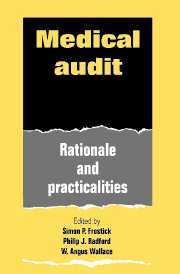Book contents
- Frontmatter
- Contents
- List of contributors
- Foreword
- Foreword
- 1 Introduction
- 2 Audit: historical and future perspectives
- 3 Audit philosophy
- 4 Medical audit: a view from the centre
- 5 Audit: a view from the Royal College of Surgeons of England
- 6 The regional viewpoint
- 7 Medical audit: the needs of the District Health Authorities
- 8 Resource management and budget holding
- 9 Unit and district information systems
- 10 Read codes and medical audit
- 11 Data capture direct from doctors
- 12 Computer systems: practice, limitations and pitfalls
- 13 Paediatric audit
- 14 Audit in obstetrics and gynaecology
- 15 Audit in general surgery
- 16 Orthopaedic audit: guidelines and hints
- 17 Installing audit in general practice and general dental practice
- 18 Clinical audit in psychiatry. Models for audit in mental health
- 19 Audit in anaesthesia
- 20 Audit in intensive care
- 21 Medical audit: lessons from the USA
- 22 Quality control in health care: the Dutch experience
- 23 Medical audit: experience from Sweden
- 24 Performance indicators
- 25 Measuring outcome and quality control
- 26 Audit: will it work?
- 27 What has been achieved so far?
- 28 A practical guide to audit
- Index
19 - Audit in anaesthesia
Published online by Cambridge University Press: 30 September 2009
- Frontmatter
- Contents
- List of contributors
- Foreword
- Foreword
- 1 Introduction
- 2 Audit: historical and future perspectives
- 3 Audit philosophy
- 4 Medical audit: a view from the centre
- 5 Audit: a view from the Royal College of Surgeons of England
- 6 The regional viewpoint
- 7 Medical audit: the needs of the District Health Authorities
- 8 Resource management and budget holding
- 9 Unit and district information systems
- 10 Read codes and medical audit
- 11 Data capture direct from doctors
- 12 Computer systems: practice, limitations and pitfalls
- 13 Paediatric audit
- 14 Audit in obstetrics and gynaecology
- 15 Audit in general surgery
- 16 Orthopaedic audit: guidelines and hints
- 17 Installing audit in general practice and general dental practice
- 18 Clinical audit in psychiatry. Models for audit in mental health
- 19 Audit in anaesthesia
- 20 Audit in intensive care
- 21 Medical audit: lessons from the USA
- 22 Quality control in health care: the Dutch experience
- 23 Medical audit: experience from Sweden
- 24 Performance indicators
- 25 Measuring outcome and quality control
- 26 Audit: will it work?
- 27 What has been achieved so far?
- 28 A practical guide to audit
- Index
Summary
Introduction
Audit in anaesthesia involves setting standards of anaesthetic practice, monitoring the application of those standards, measuring the outcome of care, identifying strengths and deficiencies, and implementing changes that improve clinical practice. The specialty of anaesthesia is valuable for audit research because in the UK anaesthetists are the most numerous of all hospital doctors, they have more direct patient-contact time concentrated into a relatively shorter period than other speciality, the care is usually provided at a one-to-one level or higher and anaesthetic responsibilities can be clearly defined.
In the United Kingdom, audit of anaesthetic practice occurs at a national and local level. At national level the College of Anaesthetists is responsible for formal examination of anaesthetists in training and for inspecting hospitals for postgraduate training and accreditation. College tutors are appointed in individual hospitals to provide a direct link with the college and to exercise an important pastoral role for the trainees. Together with the Association of Anaesthetists of Great Britain and Ireland, the college sets standards relating to the structure of anaesthetic departments and the work which they perform. While these standards do not carry legal weight, failure to meet a basic minimum level may result in hospital accreditation for junior training being withdrawn, a powerful stimulus for corrective action.
- Type
- Chapter
- Information
- Medical Audit , pp. 287 - 306Publisher: Cambridge University PressPrint publication year: 1993

